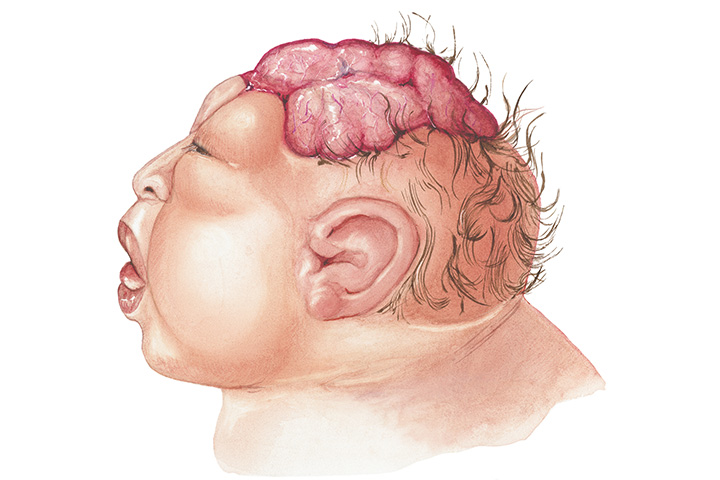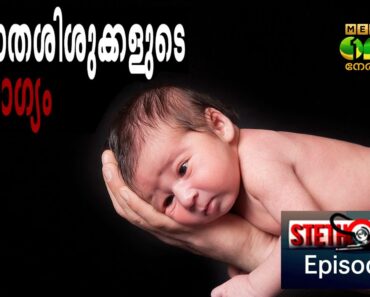Image: iStock
Anencephaly is the most severe neural tube defect (NTD) with partial or complete absence of a forebrain, including cerebral hemispheres and cerebellum. The condition is often associated with brain stem and spinal cord abnormalities. According to the U.S. Centers for Disease Control and Prevention, 1 in every 4,600 babies in the United States is born with anencephaly (1).
Usually, the neural tube forms and closes during the initial weeks of pregnancy, and it helps the formation of the baby’s central nervous system. The upper part of the neural tube forms the brain, and the lower part forms the spinal cord. Anencephaly occurs if the upper part of the neural tube fails to close. Although the brain stem may control some bodily functions, the absence of major parts of the brain can be fatal.
Read this post to know more about the causes, risk factors, symptoms, prevention, diagnosis, and outcomes of anencephaly in babies.
Risk Factors And Causes Of Anencephaly
Failure of neural tube closure can result in anencephaly. However, the exact cause of neural tube defects, including anencephaly, is not known in many cases.
The possible risk factors for anencephaly may include the following (2).
- Folic acid deficiency: Folic acid (vitamin B9) during gestation protects the fetus from NTDs, including anencephaly. Not taking folic acid supplements before or during the initial weeks of pregnancy could result in a folic acid deficiency. Dietary sources alone may not be enough to meet the folic acid requirements during pregnancy. Exposure to agents that alter folic acid metabolism in the critical neural tube development period (up to six weeks from the last menstrual period) may also be the reason for the deficiency.
- IDDM (insulin-dependent diabetes mellitus) or maternal type 1 diabetes: IDDM, also known as type 1 diabetes, may increase the risk of neural tube defects. Poorly managed pregestation diabetes and gestational diabetes may both affect the possibility of NTDs.
- Maternal hyperthermia: High body temperature in pregnant women may increase the risk of neural tube defects. For instance, using hot tubs and saunas during pregnancy could increase the risk of hyperthermia. Maternal fever in the initial weeks of gestation may also increase the chance of anencephaly and other NTDs.
- Genetic factors: Some babies may have NTDs due to familial inheritance. Autosomal recessive inheritance is often seen in families with children with anencephaly, spina bifida, and other NTDs. Autosomal dominant inheritance is possible in some families since individuals with spina bifida can reproduce. However, it is not very common since babies with NTDs usually have a low survival rate. If you already have a baby with an NTD, there is a 1 in 25 chance of having another child with an NTD, including anencephaly (2)
- Amniotic band disruption sequence: Rupture of the amniotic membrane during development can disrupt the formation of brain structures. Remnants of the amniotic membrane are often seen in such cases, and these conditions cannot be modified by folic acid supplementation.
- Maternal use of alcohol, exposure to certain chemicals, and medications may also increase the risk of anencephaly in some babies.
Signs And Symptoms Of Anencephaly
Anencephaly in babies usually presents the following clinical features (3).
- Missing cranial bones on the front side of the skull
- No bones on the back of the head
- Folding of the ears
- Cleft palate or split in the roof of the mouth
- Congenital heart defects
A baby with anencephaly may often not feel pain and be unconscious at birth. They may also have other problems, such as deafness and blindness. These issues are due to the absence of parts of the brain, such as the cerebrum and cerebellum. Babies with anencephaly usually display behaviors that are regulated by the brain stem, such as breathing, crying, coughing, and some newborn reflexes (4).
How To Prevent Anencephaly?
Anencephaly cannot be prevented in most cases. The following precautions from the preconception period and initial weeks of pregnancy may reduce the risk of anencephaly in some cases (5).
- Seeking preconception care and early prenatal care can be beneficial for mothers to have a healthy pregnancy and baby.
- Folic acid (vitamin B9) supplementation during pregnancy could lower the risk of neural tube defects. All women of childbearing age are advised to take multivitamins containing folic acid.
- Consuming folic acid-rich foods, such as nuts, citrus fruits, green leafy vegetables, beans, and fortified cereals, could provide a healthy dietary intake of folic acid.
- Starting folic acid supplementation before conception is recommended even if you are eating a folic acid-rich diet. Dietary intake alone may not be sufficient during pregnancy, and supplementation is recommended.
- Extra folic acid is recommended before a woman’s second pregnancy if they already had a child with a neural tube defect. They may have to take extra folic acid from one or two months before conception and then through the first trimester.
- Seeking alcohol deaddiction therapies before planning for a child and taking only prescription medications can lower the risk for NTDs.
- Avoid hot tubs and saunas during pregnancy since these may increase maternal hyperthermia.
- Contact your doctor and treat fever in pregnancy as soon as possible.
Diagnosis Of Anencephaly
Anencephaly can be diagnosed before or after birth. Blood or serum analysis and ultrasound exams are commonly used for prenatal screening of anencephaly. In some cases, anencephaly may not be identified during pregnancy and often discovered at birth. Doctors can diagnose anencephaly with a physical examination after birth.
The prenatal examinations for anencephaly could include the following.
1. Quad screen
The quad screen includes blood tests to identify four substances made by the fetus and placenta. Levels of these substances in maternal blood help identify the risk of neural tube defects and other problems. This is usually done between 16 to 18 weeks of pregnancy. The following substances are measured during a quad screen (6).
- Alpha-fetoprotein (AFP) are proteins made by the growing baby in the uterus
- Human chorionic gonadotropin (hCG) from placenta
- Estriol is a form of estrogen made by the baby and placenta
- Inhibin hormone is produced by the placenta
Measurements of these substances are entered into a formula to predict the probability of having a baby with neural tube defects and chromosomal anomalies. Serum AFP values are often adjusted for mothers with IDDM during quad screens. The following conditions are suspected based on the quad screen.
- Neural tube defects, including spina bifida, could be associated with high AFP levels.
- Chromosomal anomalies, such as Down syndrome (trisomy 21), could be associated with low AFP levels and abnormal levels of other markers. All markers can be low in Edwards syndrome (trisomy 18).
The quad screen is not a conclusive diagnostic test. In 20% of anencephaly cases, the incompletely formed neural tube is covered with skin or bone, and maternal markers may not be changed (3).
2. Prenatal ultrasound
Sonography (ultrasound) may detect anencephaly as early as 11 weeks of gestation. The absence of tissue above the orbits (eye sockets) and the absence of skull bones may indicate anencephaly.
The absence of cranial bones may cause frog eye or Mickey Mouse appearance on sonographic images due to bulging orbits. Polyhydramnios (excess amniotic fluid) is also seen if the baby has anencephaly since the condition may impair swallowing.
3. Amniocentesis
Amniocentesis is a diagnostic procedure involving the collection of amniotic fluid using a needle. Amniotic alpha-fetoprotein (AFAFP) measurements can predict anencephaly and other defects in the late first and second trimester. Cytogenetic analysis of amniotic fluid is also performed to look for fetal chromosomal abnormalities.
The postnatal (after birth) diagnostic tests for anencephaly may include the following.
4. Physical examination
Anencephaly can be apparent at birth due to the absence of a skull cap and parts of the brain. Usually, the cranial lesions are not covered by the skin. However, some babies may have cranial lesions covered by skin. It could be the reason for normal AFP levels in maternal serum during the quad screen test.
5. MRI scan
A postnatal MRI scan is often done to look for brain abnormalities. If other malformations are also present with anencephaly, doctors may order cytogenetic analysis to understand the exact cause. The analysis could also be helpful to plan the next pregnancy.
Anencephaly And Microcephaly
Cephalic disorders are congenital conditions that damage or cause abnormal development of the nervous system. Both anencephaly and microcephaly are cephalic disorders. Microcephaly is a condition when a baby is born with a smaller head circumference than normal. In contrast, anencephaly is the absence of parts of the brain and skull.
Reduced size and absence of parts of the brain can interfere with normal brain functions. Thus, microcephaly and anencephaly can be in some ways similar. However, microcephaly can also develop in early infancy due to various factors, which prevent brain development.
Unlike anencephaly, a child with microcephaly may have a normal face and other body parts, except a small head. Microcephaly may result in developmental problems and a short lifespan compared to other babies without cephalic conditions.
Treatment For Anencephaly In Babies
There is no cure for anencephaly. Doctors may provide supportive care based on each baby’s requirement to keep them as comfortable as possible (7).
Even though anencephaly is identified during pregnancy, it cannot be treated in utero. If anencephaly is diagnosed prenatally, gynecologists may recommend termination of pregnancy in some cases. Parents are often provided with supportive care and psychological and genetic counseling, irrespective of their choice.
Prognosis Of Anencephaly
Anencephaly has an extremely poor prognosis. Most babies with anencephaly die shortly after birth or within a few days or weeks. Stillbirth or fetal death after 20 or 28th weeks of gestation is seen in many anencephaly cases.
Abnormal fetal presentations in delivery are common in anencephaly. Some pregnancies may go post-term (pregnancy extended to or beyond 42 weeks) due to delay in precipitation of labor since some babies with anencephaly may lack a pituitary gland. Labor induction is often required in such cases.
Anencephaly may cause polyhydramnios (excess amniotic fluid) in some cases, resulting in maternal abdominal discomfort and enlargement during pregnancy. This may increase the risk of preterm labor (8). Parents with a confirmed case of anencephaly in their baby may consider counseling in conjunction with the doctor’s advice on the prognosis of the pregnancy.
Anencephaly in babies is a neural tube defect with no known treatment. Adequate prenatal care, such as consuming enough folic acid, may reduce the risk. If you have a family history of NTDs or already have a baby with anencephaly, speak to a doctor or genetic counselor to plan your subsequent pregnancies.





![Rolling Over Baby – Complete Guide + Exercises. [2020] Rolling Over Baby – Complete Guide + Exercises. [2020]](https://usparenting.com/wp-content/uploads/2020/10/1603621996_maxresdefault-370x297.jpg)




























